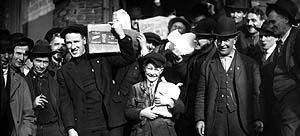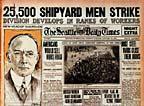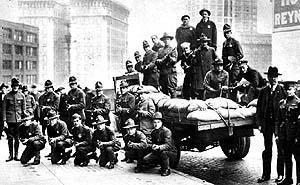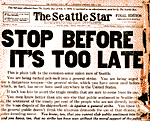

This story ran in The Seattle Times on March 31, 1996
By Sharon Boswell
and Lorraine McConaghy
Special to The Times

The Seattle General Strike of 1919 began with smiles and optimism
as supporters gathered groceries for striking union workers.
Photo Credit: Webster and Stevens Coll., Museum of History and Industry.
"SOLDIERS AND SAILORS MUST BE EMPLOYED NOW,"
the bold headlines read as World War I neared its end in November 1918.
But as more heroes of war arrived home looking for work,
the heroes of the homefront -- the laborers who had kept local industries running
-- began their own
fight to maintain fair wages and recognition for their efforts.
American workers had accomplished a "miracle of production"
to support the country's war effort, but with the Armistice signed and peace
negotiations under way, curtailments had begun quickly. Seattle's huge shipyards
had paid high wages to attract men during the war years, but as production needs
declined, the government intervened, establishing a nationwide pay scale much lower
than Puget Sound workers found acceptable.

On Jan. 21, 1919, news that 25,500 shipyard workers had begun a
strike in
Seattle overshadowed reports of the Paris peace negotiations. The Metal Trades Council
staged the walkout, seeking to maintain $1 an hour for its skilled workers.
In sympathy with their demands, the city's Central Labor Council
voted to hold a referendum, allowing affiliated unions to vote on joining the metalworkers
in a general strike.

Fearing the worst from the strike, the city prepared to fight radicals,
even forming its own machine-gun unit.
Photo Credit: Seattle Times
The threat of a walkout by the council's 130 locals,
representing more than 30,000 additional workers, caused citywide consternation.
"This is the time for Common Sense," editorials in The Times pleaded. But as union after union
voted to join the protest, Seattle braced itself for the worst.
The "latest developments" in the strike began to appear daily
on the front page of local papers; articles warned residents about potentially
"grave difficulties in obtaining the necessities of life."
Dire predictions abounded: Seattle would be paralyzed.
Alaska was threatened with famine if docks shut down. Milk supplies would disappear
in two days. Meat markets would have no meat and bakeries no flour for bread.
Streets would be dark, electric heaters cold, 50,000 homes without light.
A local citizens committee tried to help with arbitration,
but the government nixed any possibility of a settlement between shipyard owners and workers.
If exceptions were made for some workers, no contract would be sacred, federal officials argued,
explaining their no-compromise position in full-page newspaper announcements.
Some residents took sides but most stocked up on oil stoves, lamps and groceries,
afraid of what might happen.
Ministers used their pulpits to urge forbearance, while Seattle's
flamboyant mayor, Ole Hanson, promised to preserve order and protect life and property.
As tensions grew, rumors persisted that a radical takeover of the city was
imminent, and that the Bolsheviks, successful in Russia, hoped to start a revolution in Seattle.
 The chief of police urged people to stay off the streets and
temporarily deputized nearly 3,000 soldiers, sailors and guards, even forming
a machine-gun squad. A special edition of The Seattle Star urged workers to "Stop Before It's Too Late,"
and the message was printed as a paid announcement in other papers.
The chief of police urged people to stay off the streets and
temporarily deputized nearly 3,000 soldiers, sailors and guards, even forming
a machine-gun squad. A special edition of The Seattle Star urged workers to "Stop Before It's Too Late,"
and the message was printed as a paid announcement in other papers.
But it was too late. And at
10 a.m. on Feb. 6, 1919, most union men and women walked off their jobs. Seattle's general strike,
the largest in the United States, shut down the city for several days. Streets were quiet.
Most newspapers ceased publication, streetcars stopped running, and industry ground to a halt.
But for average citizens the strike's consequences were not as severe as predicted.
No babies were deprived of milk, and local residents, though inconvenienced, were not without food,
lights or heat. Above all, there was no violence, no revolution in the streets.

Despite dire predictions, downtown Seattle streets
were calm
as people milled around, waiting for strike news.
Photo Credit:UW Special Collections
SEATTLE'S LABORING PEOPLE HAD PROVED A POINT: Union solidarity was possible.
But where would the strike lead them? Radical activist Anna Louise Strong, editorializing
in the city's labor paper, The Union-Record, had used the stirring phrase "No One Knows Where"
to underscore the strike's potential.
But instead of leading labor to new gains, the strike seemed merely to provide
fuel for harshly reactionary responses. An anti-syndicalism law passed by the state Legislature
early in its 1919 session was used as a basis for numerous raids on Socialist and radical
labor headquarters, police disruption of meetings, and the arrest of suspected revolutionaries.
When three marchers were mysteriously shot in Centralia's 1919 Armistice Day parade,
vigilantes retaliated by lynching a radical union leader, Wesley Everest. The Seattle Union Record's
sympathetic coverage of the union side prompted federal marshals to suspend publication of the paper
for several days, charging its editor with sedition.
Others made political capital of the continuing fear of labor radicalism.
Seattle's Mayor Hanson -- whose pledge that "anarchists in this community shall not rule its affairs"
had gained him nationwide recognition -- resigned from office. He launched a cross-country speaking
tour, hoping the publicity might even propel him into the Republican presidential nomination.
But for labor, the strike that began with such hope and proceeded with such
calm ended with bitterness and repression. The strike that could go "No One Knows Where"
in the short term led the unions nowhere nearer their goals.
Historians Sharon Boswell and Lorraine McConaghy teach at local universities
and do research, writing and oral history.
Original newspaper graphics courtesy of the Seattle Public Library.
More photos
Table Topics




Copyright © 1996 The Seattle Times Company



 The chief of police urged people to stay off the streets and
temporarily deputized nearly 3,000 soldiers, sailors and guards, even forming
a machine-gun squad. A special edition of The Seattle Star urged workers to "Stop Before It's Too Late,"
and the message was printed as a paid announcement in other papers.
The chief of police urged people to stay off the streets and
temporarily deputized nearly 3,000 soldiers, sailors and guards, even forming
a machine-gun squad. A special edition of The Seattle Star urged workers to "Stop Before It's Too Late,"
and the message was printed as a paid announcement in other papers.